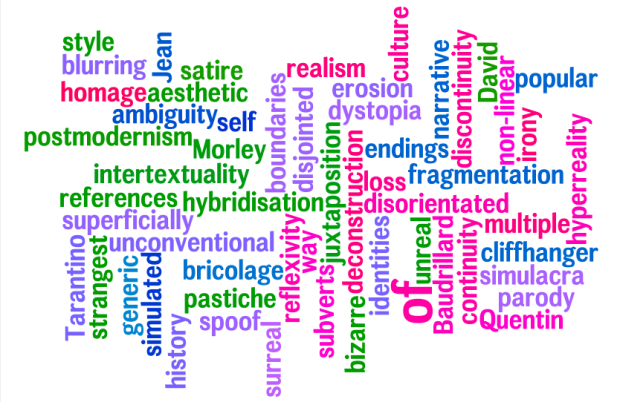
Post stands for after. Modern stands for present or recent time. When we combined these words which becomes postmodern means that after present time and how can we know what is going to happen after this modern life? Therefore this describes postmodernism, a complex term used with several meanings, usually involving self-reflexive contemporary culture and media or more widely, a set of attitudes to the contemporary world.
Postmodernism associated with deconstruction and post-structualism.
Deconstruction is when media is sliced, diced and stitched (chopped things off, break into pieces and create a new one).
Post-structualism is a variation of structuralism, often seen as a critique, emphasising plurality of meaning and instability of concepts that structuralism uses to define society, language, etc.
Postmodernists believe that artistic creativity and newness can no longer happen as in today’s society everything has been done. As mention above, media text is being deconstructed rather than newness being created which results in erosion of history and originality. There are several conventions of postmodernist films which include
- Intertextuality – describes the variety of ways in which media texts interact with other texts.
- parody – also known as a spoof. A mockery of previous media text with comedic elements by means of satiric or ironic imitation.
- pastiche – this is an imitation of previous media texts in positive sense that it celebrates rather than mocks the work it imitates.
- homage – is more like a tribute to previous media text. It is a special honour or respect shown publicly to the producers, directors, or anyone who gives the inspiration.
- satire – it is a technique in which a target is held up merciless ridicule. Satire often combines anger and humour it can be profoundly disturbing – because it is essentially ironic & sarcastic – it is often misunderstood. Purpose of satire is not primarily humour but criticism of an individual or a group in a witty manner.
- Self reflexivity – this is when a ‘text’ points out to the audience that it is a ‘text’. This level of self awareness points to how ‘texts’ are constructed. This can be negotiated reading depends on how the audience received the media text.
- Hyperreality – is an inability of consciousness to distinguish reality form simulation of reality, especially in technologically advanced postmodern societies. Jean Baudrillard once said we live in a world where there is more and more information, less and less meaning.
- Generic hybridisation – this is when a text mixes the elements of two or more genres together. E.g – romance + comedy = romantic comedy
- Non-linear narratives – this is a technique used where a story is told out of order and can often disorientate the audience such as dream immersions.
- Juxtaposition – this is when two things contradict to each other are being placed together.
- Unknown Identities – this is where the character doesn’t have a name. The character’s name is blurred out and becomes unknown. This may be conveyed at the end of the film or it won’t be conveyed at all in order to give out the enigmatic codes as well as to disorientate the audience.
